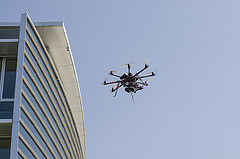

Photo by Gabriel Garcia Marengo is licensed under CC BY 2.0
Who could have predicted a few years ago that something called a “drone” would have a projected economic impact of $10 billion? Most people had never heard of drones until they became so prevalent in recent years.
Drones are now a force to be reckoned with and they are controversial to say the least. The Federal Aviation Administration (FAA) has unveiled regulatory rules for the use of unmanned aircraft systems (UAS) or drones. The new proposed regulations will definitely not be embraced by many interested parties.
The proposed rules, which are not yet law, require many things. Operators must pass an aeronautical knowledge test and be vetted by the FAA. No one under age 17 will be allowed to operate a UAS.
And, the FAA wants users to be within “unaided visual sight” of any drone being operated. Nighttime drone use will not be allowed and drones cannot be flown above people who are “not involved in the flight.”
Drones also cannot exceed speeds of 100 miles per hour or weigh more than 55 pounds. A UAS must not fly higher than 500 feet and no products or people can be transported by drones. In addition to these proposed regulations, the White House added even more stipulations that will apply when drones are used by federal agencies.
Drones are currently used for military training, to monitor federal lands as well as wildfires, to conduct scientific research, to survey the border and to support law enforcement. Governmental agencies will have to change many procedures when the new regulations become law.
Farmers use drones to survey land. In California, winemakers use drones to take aerial footage of the land to observe the soil and gather data that helps them grow better grapes. Under the proposed regulations, both types of drone use may be prohibited.
United States citizens will also be impacted by the new regulations. Companies like Amazon and others planning to implement drone delivery for online consumer purchases will not be able to do so. Amazon’s latest shipping innovation is Prime Air, a drone delivery service designed to allow consumers to receive same-day orders. The Prime Air project is an effort by Amazon to reduce the loss of more than $8.829 billion in shipping costs over the last three years. If drones cannot carry products, the company will not be able to reduce the $3 billion spent each year on shipping costs or recoup the $1.7 billion that has been spent on research and development.
Google could feel pain also because the company has been investing in aerial technology through its semi-secret research department called Google X. Several visionary initiatives are currently in development stages, but drone regulations will impact all future decisions.
Attempts will be made to soften the proposed regulations, but that may or may not happen. Air safety may trump everything else. There will likely be compromises, but finding a way for all parties to co-exist will not be easy.
Want to stay updated on the latest changes to drone regulations? Follow the Strategic Partnerships, Inc. blog for insights.
